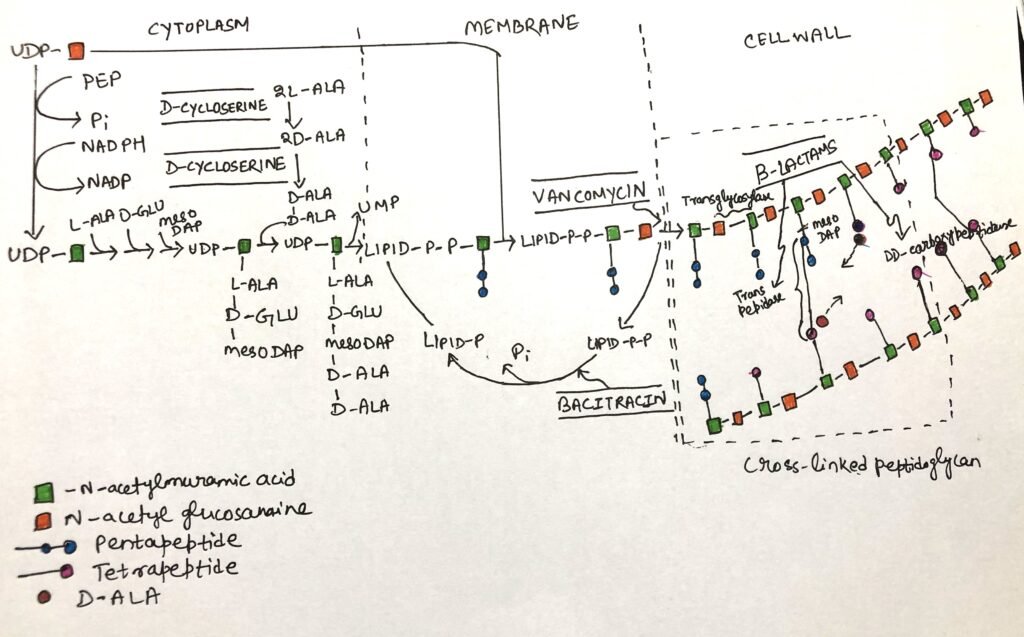In this article, I briefly describe how different antibiotics inhibit the cell wall synthesis of microorganisms.
Antibiotics
Antibiotic refers to metabolic substances produced by a microorganism that, even in small quantities, can inhibit or harm other microbes. Vuillemin, in 1898, introduced the concept of antibiosis, where one organism eliminates others to survive. However, this early definition does not fully align with the modern understanding of antibiotics, as proposed by Waksman in 1945. According to Waksman, antibiotics are chemical compounds derived from microbes that display antimicrobial effects even at low concentrations.
Research by Scientists
The antimicrobial effects of antibiotics were recognized long before the term itself was coined. In 1881, Tyndall observed that bacterial cultures became clear when mold developed on their surface, indicating microbial inhibition. Similarly, Pasteur and Joubert noted that while anthrax bacilli grew well in sterile urine, their growth was suppressed when other microorganisms were present. Building on this, Emmerich and Low demonstrated in 1901 that injecting rabbits with liquid cultures of Pseudomonas aeruginosa protected them from anthrax infection. They attributed this effect to a substance they named pyocyaneus, which they believed was an enzyme produced by Bacillus pyocyaneus.
An early clinical use of bacterial antagonism was seen in 1899 when Metchinkoff recommended lactobacilli for treating dysentery. This approach, known as replacement therapy, involved using innocuous microbes to displace disease-causing ones. However, modern antibiotic therapy relies not on microbial replacement, but on extracting and applying active compounds with inhibitory effects produced by antibiotic-producing organisms.
In 1924, Gratia and Dath initiated the first systematic investigation into antibiotics, leading to the discovery of actinomycetin in actinomycetes—soil-dwelling microbes that have since become a major source of antibiotics. Although actinomycetin was never used to treat infections, it played a role in breaking down bacterial cultures for vaccine preparation.
The Discovery of Penicillin by Alexander Fleming
In 1929, Alexander Fleming experimented using an agar plate inoculated with Staphylococcus aureus. During the process, the plate accidentally became contaminated with a mold. Interestingly, a clear zone had formed around the mold colony, indicating that bacterial growth was inhibited or the bacteria had lysed. Intrigued by this phenomenon, Fleming isolated the mold and began his research on its properties. With substantial support from researchers in England and the United States—and at considerable expense—the active compound from Fleming’s “contaminated mold” was eventually developed into a groundbreaking drug. The mold was identified as a species of Penicillium, and Fleming named the antibiotic “penicillin.”
The Mode of Action of Antibiotics
Antibiotics can be categorized based on their chemical structure and mode of action. Functionally, they are classified as either bactericidal, which kill bacteria, or bacteriostatic, which inhibit their growth. The classification according to mode of action highlights how these drugs affect microbial cells. They exert their effects by disrupting vital processes such as cell wall synthesis, damaging the cytoplasmic membrane, inhibiting nucleic acid and protein synthesis, or interfering with specific enzyme systems essential for microbial survival.
Inhibition of Cell Wall Synthesis
Certain antibiotics exert their antimicrobial effects by targeting the biosynthesis of peptidoglycan, a crucial component of the bacterial cell wall. These include penicillins, cephalosporins, cycloserine, vancomycin, and bacitracin.
Peptidoglycan provides structural strength to the bacterial cell wall through a network of polymer strands composed of repeating units of N-acetylglucosamine and N-acetylmuramic acid, crosslinked by short peptides. This crosslinking pattern is essential for maintaining the rigidity and integrity of the cell wall. The formation of peptidoglycan involves multiple biosynthetic steps, and disruption at any stage can impair cell-wall synthesis. Early research demonstrated that some antibiotics prevent the formation of this polymer, thereby hindering the development of a functional bacterial cell wall.
The Action of Penicillins
Penicillin, the first of the modern antibiotics and still an indispensable therapeutic agent, is produced by Penicillium notatum, Penicillium chrysogenum, and other related mold species. It is primarily effective against gram-positive bacteria, certain spirochetes, and gram-negative diplococci. However, its use can sometimes lead to sensitivity reactions, which may range from mild skin irritation to severe anaphylaxis.
Penicillins are β-lactam antibiotics with a common core structure—a β-lactam-thiazolidine ring (Figure 1) and variable side chains that determine their properties. Natural penicillins, often prepared as salts, are stable in saliva and bile but are deactivated by heat, acids, and certain chemicals. Penicillin V is more acid-stable than others.

A key advancement in creating semisynthetic penicillins was the discovery of 6-aminopenicillanic acid (6-APA), the shared nucleus of all penicillins. Using Penicillium chrysogenum and enzymatic methods, scientists isolated 6-APA for attaching custom side chains. Phenethicillin was among the first semisynthetic penicillins, offering better absorption than penicillin V and comparable effectiveness to penicillin G.
The Action of Ampicillin
This semisynthetic penicillin is effective against a broad range of bacteria. It exhibits strong bactericidal activity and is non-toxic, but it is not resistant to penicillinase enzymes. It can be taken orally. The chemical structures of three penicillins are illustrated in the accompanying figure (Figure 2). In addition, various semisynthetic penicillins have been developed for therapeutic purposes.

Penicillins work by disrupting the final steps of peptidoglycan synthesis in bacterial cell walls. Specifically, they block the transpeptidase enzyme responsible for cross-linking peptidoglycan chains. As a result, penicillins are lethal to actively growing bacterial cells.
The Action of Cephalosporins
The marine fungus Cephalosporium acremonium produces a group of antibiotics known as cephalosporins. This fungus closely resembles species of Penicillium. Cephalosporins are effective against gram-positive and gram-negative bacteria and share similar antibacterial properties with semisynthetic penicillins. They are therapeutically useful and exhibit low toxicity. Structurally, the core (nucleus) of cephalosporins (Figure 3) is similar to that of penicillins. Their action involves inhibiting the transpeptidase enzyme responsible for cross-linking in bacterial cell wall synthesis, making them bactericidal to actively growing bacterial cells.

The Action of Cycloserine
Cycloserine was initially discovered as a natural antibiotic produced by Streptomyces species, but is now produced synthetically. Structurally similar to alanine (as shown in Figure 4), this antibiotic is primarily used in treating tuberculosis. However, its clinical use is limited due to significant side effects. Cycloserine exerts its antibacterial action by disrupting peptidoglycan synthesis, specifically targeting the formation of the peptide portion of the bacterial cell wall. It inhibits two key enzymes—alanine racemase and D-alanyl-D-alanine synthetase— essential for synthesizing the pentapeptide chains in peptidoglycan.

The Action of Bacitracin
Bacillus subtilis produces bacitracin, a polypeptide antibiotic. Due to its toxicity to both human and animal cells, it is not suitable for systemic use in chemotherapy. However, it is effectively used as a topical agent to treat infections caused by Gram-positive bacteria.
The Action of Vancomycin
Vancomycin, produced by Streptomyces orientalis, is a complex antibiotic of amino acids and sugars. It works by blocking bacterial cell wall synthesis. Specifically, it binds to the D-alanyl-D-alanine portion of the peptide side chains in membrane-bound intermediates, preventing the proper formation of peptidoglycan.
Figure 5 presents a schematic overview of the mechanisms by which various antibiotics inhibit bacterial growth through interference with cell wall synthesis.

Conclusion
The concept of antibiosis was originally introduced by Vuillemin in 1898, who defined it as a condition where one organism eliminates others to survive. According to Waksman, antibiotics are chemical compounds derived from microbes that display antimicrobial effects even at low concentrations.
Antibiotics exert their effects by disrupting vital processes such as cell wall synthesis, damaging the cytoplasmic membrane, inhibiting nucleic acid and protein synthesis, or interfering with specific enzyme systems essential for microbial survival.
Certain antibiotics exert their antimicrobial effects by targeting the biosynthesis of peptidoglycan, a crucial component of the bacterial cell wall. These include penicillins, cephalosporins, cycloserine, vancomycin, and bacitracin.
Penicillin, the first of the modern antibiotics and still an indispensable therapeutic agent, is produced by Penicillium notatum, Penicillium chrysogenum, and other related mold species. It is primarily effective against gram-positive bacteria, certain spirochetes, and gram-negative diplococci. Ampicillin is effective against a broad range of bacteria. It exhibits strong bactericidal activity and is non-toxic, but is not resistant to penicillinase enzymes.
The marine fungus Cephalosporium acremonium produces a group of antibiotics known as cephalosporins. This fungus closely resembles species of Penicillium. Cephalosporins are effective against gram-positive and gram-negative bacteria and share similar antibacterial properties with semisynthetic penicillins. Cycloserine exerts its antibacterial action by disrupting peptidoglycan synthesis, specifically targeting the formation of the peptide portion of the bacterial cell wall. Vancomycin, produced by Streptomyces orientalis, is a complex antibiotic of amino acids and sugars. It works by blocking bacterial cell wall synthesis.
You may also like:
- The role of desiccation, filtration, osmotic pressure, and radiation in controlling microorganisms
- Antibiotics inhibit nucleic acid and protein synthesis in bacteria
- Microorganisms develop drug resistance

I, Swagatika Sahu (author of this website), have done my master’s in Biotechnology. I have around fourteen years of experience in writing and believe that writing is a great way to share knowledge. I hope the articles on the website will help users in enhancing their intellect in Biotechnology.




